January 27, 2015
by Carole Zangari -
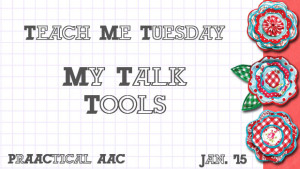
It’s a great day to learn about My Talk Tools! Product Website Knowledge Base: My Talk Tutorials Community Forum Where to Go For Help: support@mytalk.zendesk.com or Contact Form
Filed under: PrAACtical Thinking
Tagged With: My Talk Tools, Teach Me Tuesday
January 26, 2015
by Carole Zangari -
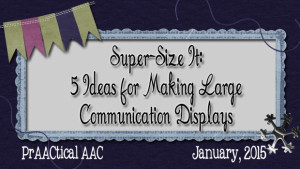
One of the coolest things about 2014 was that it seemed like the field of AAC reached a tipping point regarding the idea of aided language input. There are some differences in terminology (e.g., aided language stimulation, aided modeling), but the Big Idea is this: To teach AAC, be a speaker of AAC. Learners need competent language models, and if we’re not using the AAC ourselves, chances are that no one else is easier. If you don’t think that’s a problem, try learning a foreign language from a teacher who doesn’t speak it to you. Not the most enjoyable, effective, or efficient way to learn. I had such a great visit to schools in Oakland, Michigan this fall, and one of the (many) highlights was being in classrooms where teachers and SLPs are taking this to heart. True, they have some great AT leadership and had lots of training, but... [Read More...]
Filed under: PrAACtical Thinking
Tagged With: aided language input, modeling, Oakland Schools
January 25, 2015
by Carole Zangari -
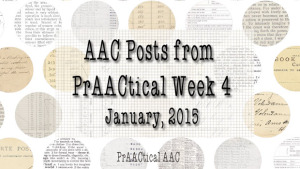
Monday: PrAACtical Interactions with Law Enforcement Tuesday: A Year of Core Words: Sentences We Can Model Wednesday: Video of the Week – Recommended Practices for Beginning Communicators Thursday: PrAACtical Resources: What Can You Do With PVC?
Filed under: PrAACtical Thinking
January 22, 2015
by Carole Zangari -
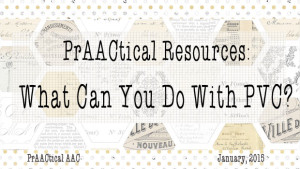
This gem of a book from the ATEN Coordinating Unit at Orange County Schools is an oldie, but a goodie! PVC: Practical, Versatile, Cheap AT Supports contains easy-to-follow directions for switch stands, tilting eye gaze frames, mobile floor stands, and much more.
Filed under: PrAACtical Thinking
Tagged With: ATEN, DIY, Orange County, PVC
January 20, 2015
by Carole Zangari -

Gone to an AAC conference presentation lately? Seen an AAC webinar? Read an article on AAC therapies? Chances are that they’ve at least mentioned some of the benefits of teaching core vocabulary. Teaching a relatively small set of powerful words is a strategy that empowers language learners and allows them to communicate across contexts. If you are following along with our A Year of Core Words (2013) or A(nother) Year of Core Vocabulary (2014), you may have printed out some of the word cards to use with the AAC learners in your life. Thanks to the kindness of PrAACtical AAC readers we have posts with a variety of resources: Minspeak/Unity version: 2013 PCS versions: 2013 , 2014 Speak for Yourself version: 2014 SymbolStix version: 2013 Once you have them, the idea is to use those to plan learning activities that focus on those particular core words for the month. Let’s... [Read More...]
Filed under: PrAACtical Thinking
Tagged With: aided language input, core vocabulary, model, Year of Core
January 19, 2015
by Carole Zangari -
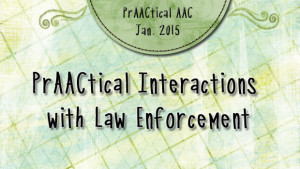
If you were ever stopped by the police, you know that it can be an anxiety-producing situation. Even when you’ve done nothing wrong, your heart may race, your hands may tremble, and you may stumble over your words. It is easy to imagine how much more difficult these situations would be for those with speech disabilities, particularly those with problems in social interaction. At a meeting a few weeks ago, I was excited to learn about The Wallet Card Project, a collaborative effort between the Disability Independence Group, the Coral Gables Police Department, and the UM-NSU Center for Autism and Related Disabilities (UM-NSU CARD). The Wallet Card Project created free materials to be used in helping individuals with Autism Spectrum Disorder (ASD) and their families gain skills in interacting successfully with police. The trainings address applicable laws in an easy-to-understand fashion that includes both real examples and hypothetical scenarios. Participants... [Read More...]
Filed under: PrAACtical Thinking
Tagged With: Coral Gables Police, Disability Independence Group, law enforcement, police, UM-NSU CARD, Wallet Card
January 18, 2015
by Carole Zangari -
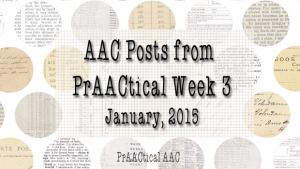
Monday: Video Modeling & AAC Tuesday: Teach Me Tuesday: Communicate Easy Wednesday: Video of the Week – AT Throughout the Day for Students with Significant Disabilities Thursday: Materials for Modeling January Core Words
Filed under: PrAACtical Thinking
January 15, 2015
by Carole Zangari -
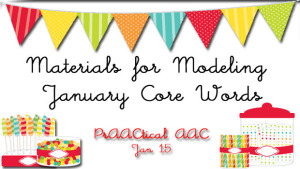
It is so encouraging to see so many SLPs, educators, families, and others support the acquisition of core vocabulary. In this post, we’re thrilled to be sharing a resource by Alison Wade, an SLP from Massachusetts who works with a number of AAC-using children and adults. Alison generously offered to share this document with our 2013 set of January core words represented by PCS, SymbolStix, and traditional orthography. You can download it by clicking the image below or visiting the Download section of our eToolbox. Need ideas for how to use it? Check out our previous post. Thanks, Alison!
Filed under: PrAACtical Thinking
Tagged With: Alison Wade, core vocabulary, PCS, Symbol Stix
January 13, 2015
by Carole Zangari -

It’s a new year and that makes it a great time to explore some new AAC apps. We’re checking out some of the features of Communicate Easy. Join us! Product Overview Features and Tutorials Where to Go For Help and Contact page
Filed under: PrAACtical Thinking
Tagged With: Communicate Easy, Teach Me Tuesday
January 12, 2015
by Carole Zangari -

Video modeling is an empirically supported instructional strategy that can help some learners acquire and use a range of new skills. It involves videotaping the expected or desired behavior so that our clients can see, hear, and better understand the skills they are trying to learn. We’ve posted videos about it in the past and know that many of you use it or have considered using it in your clinical practice. Most of the applications have been with speaking children and young adults, but many AAC learners can benefit as well. If you’re thinking of trying out this strategy in your own practice, here are some resources that might be helpful. In a nutshell: Visit the National Center for Professional Development on Autism to review the EBP practice brief on video modeling. Their documents are great for sharing with families and other team members, too. Getting started: Visit Dr. Christine Reeve’s... [Read More...]
Filed under: PrAACtical Thinking
Tagged With: intervention, video modeling, video self modeling









